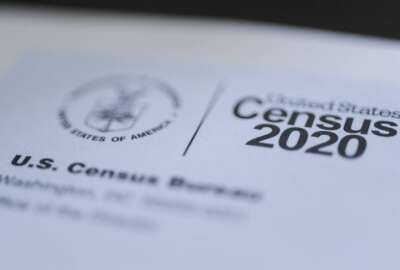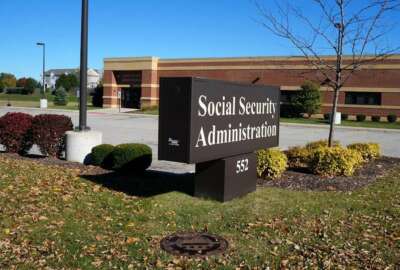Hubbard Radio Washington DC, LLC. All rights reserved. This website is not intended for users located within the European Economic Area.
On Air: Federal News Network
Trending:
Paul to lead new information sharing strategy effort
The Program Manager for the Information Sharing Environment says the three-year-old document needs to be updated and expanded. This effort is one of five priori...
wfedstaff | June 3, 2015 12:35 pm
By Jason Miller
Executive Editor
Federal News Radio
The National Strategy for Information Sharing is but three years old – not that old when it comes to federal documents.
But changes in technology, culture and conditions necessitate not only an update, but an expansion.
“We want to build on the current document, and update it and sketch a target end vision for the Information Sharing Environment and strategies for realizing it,” said Kshemendra Paul, the program manager for the Information Sharing Environment (PM-ISE) in an exclusive interview with Federal News Radio.
Paul said he will begin working on the document this fall through an interagency process.
“We want to make sure we are engaging the frontline,” he said. “We will be using open government techniques, building on what we did for example with the SBU networks where we did the dialogue with the users. We want to make sure we are soliciting input as broadly as possible from the users.”
He adds that the White House has instructed him to expand his view to look at the totality of terrorism information sharing across all levels of government, not just focus on sharing with the state, local and tribal communities.
Paul says this is a lesson learned from the Dec. 25 attempted terrorist attack.
The national strategy is one of five priorities Paul is working on over the next year.
Only a month into his tenure as the PM-ISE, Paul is using his office’s annual report to Congress as a menu of future opportunities. The report details the accomplishments and shortcomings of the ISE in 2009.
Paul became the second program manager in July after spending three years as the Office of Management and Budget’s chief architect. He also previously worked at the Justice Department, heading up the development of the National Information Exchange Model (NIEM).
“I’ve got a real passion for this mission space, going back to when I first came into the Department of Justice,” he said. “Van Hitch, the CIO at DoJ, offered me an opportunity to come in to help with the law enforcement, counterterrorism, homeland security information sharing mission. It’s been a thread throughout my career at Justice, OMB and now here, so I see this as an arc in something [where I can] make a difference in this mission.”
Paul knows the challenges he faces to make progress. Former PM-ISE Thomas McNamara, who retired in July 2009, made the case to Congress that the PM’s role needs to be raised in terms of budget and authority.
Paul, who also is the co-chairman of the Information Sharing and Access Interagency Policy Committee along with Mike Resnick, the White House senior director for information sharing policy, puts governance and expanding relationships across government among his top priorities.
“It’s about the mission partners,” he said. “It’s about getting them engaged and continuing and strengthening it and driving results for the frontline.
He wants to create additional centers of excellence (COEs) around the government as well. He points to the FBI’s Criminal Justice Information Service (CJIS) and the Homeland Security Department’s NEIM program management office as two examples of existing COEs.
“There are a variety of these centers of excellence across the government that are taking the lead in building out aspects of the information sharing environment,” Paul said. “We’re catalyzing, supporting them, and over time new ones will develop.”
The ISE’s final priority is ensuring there is continuous improvement and innovation in how agencies share terrorist and homeland security information.
Paul said innovation is dependent on standards and that is why the NIEM and Suspicious Activity Reporting (SAR) models are so important.
“Critical to how we are trying to build out the ISE are standards on the interface,” he said. “All these mission partners, federal, state, local, tribal and private sector as they interconnect, they can do it into the net-centric ISE through an effective robust interface standard.”
He said 12 agencies are using or are considering using NIEM for all types of mission needs.
“The Office of the National Coordinator for Health IT is adopting the NIEM process and framework as the basis for functional specifications for meaningful use of electronic health records,” he said. “It really comes back to sharing best practices. In many ways, I like to think about this as the distillation of best practices around information sharing coming out of the national security space. Those best practices are now being leveraged in the health care space. That’s good government in action. It’s really exciting.”
Meanwhile, state fusion centers are adopting and using the SAR standard to improve collection and dissemination of information.
Paul said NIEM and SAR have made significant progress over the last year. He expects the further expansion of use of both standards.
The ISE also is working with the National Archives and Records Administration on the effort to reduce the number of labels for controlled unclassified information (CUI).
Paul said the ISE is providing oversight and support to NARA, and developing tagging standards for Extensible Markup Language (XML) for CUI information.
Over the next year, the ISE will work with Justice, DHS and the Office of the Director of National Intelligence on a strategy, architecture and security and privacy guidelines for a “federated interoperable environment for multiple SBU/CUI networks.”
Paul said the strategy is going through the interagency process, but wouldn’t offer much in the way of a timetable.
Paul, in his other role as co-chairman of the Information Sharing and Access Interagency Policy Committee, is leading a policy development effort to let state, local and tribal law enforcement entities access federal classified networks.
He wouldn’t offer much more on that strategy as well, except to say the goal is to harmonize federal network access policies across several agencies.
“The information assurance type of policies and the handling of classified information on state, local and tribal or private sector side is done on in a uniform way where there is a recognition of adequate safeguards and reciprocity,” Paul said.
The ISE in some ways already addressed this issue. It helped securely connect four major law enforcement networks: the FBI’s Law Enforcement Online (LEO), DHS’s Homeland Security Information Network, the intelligence community’s Intelink and the Regional Information Sharing Systems (RISSNet), run by the states.
Paul says users of these databases can find information across all four networks, send secure e-mails, use the FBI’s virtual command center and find colleagues through an online White Pages. Paul calls these “material impacts on the frontline,” which is what the ISE focuses on.
“We also did an online dialogue where we reached out to each user of the four networks and asked them for input,” he says. “It helped us to get shared perspective in what we need to do going forward.”
On top of all of these priorities, Paul plans to join the blogging world too. The ISE updated its ise.gov website with the same focus on frontline workers as many of its initiatives. Paul says he will blog occasionally, but would like to have guests from the information sharing community offer their insights too.
(Copyright 2010 by FederalNewsRadio.com. All Rights Reserved.)
Copyright © 2024 Federal News Network. All rights reserved. This website is not intended for users located within the European Economic Area.




